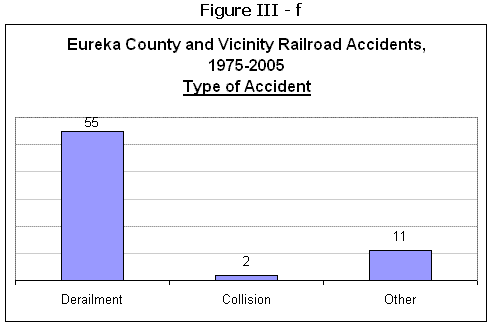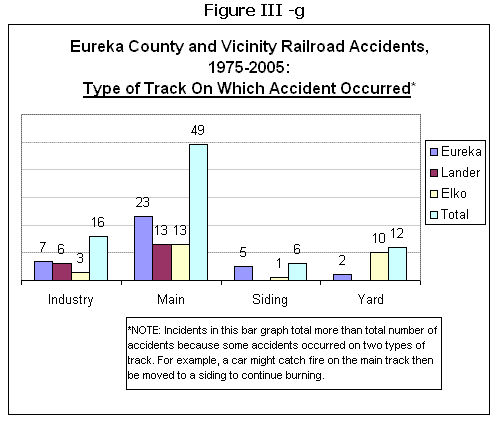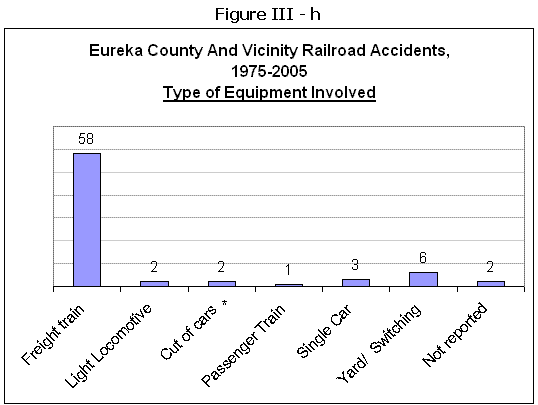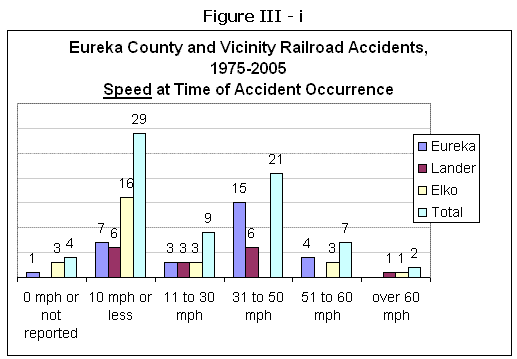

ACCIDENT DATA - continued
Characteristics of Accidents
 he following bar graphs illustrate characteristics of the reported accidents. Some of the graphs are built using only accidents from the "reportable accident" database, since sufficient information from the highway/rail crossing incidents was not available. he following bar graphs illustrate characteristics of the reported accidents. Some of the graphs are built using only accidents from the "reportable accident" database, since sufficient information from the highway/rail crossing incidents was not available.
Accident Location
Exhibits 2a and Exhibits 2b show approximate accident locations in the study area, based upon milepost locations given in FRA accident reports (Appendix B). There appear to be several areas where accidents are clustered: in and around Carlin, at Barth, at Beowawe, west of Mosel at around Mile 490 on the Overland ("Southern Pacific Railroad" on map), around Dunphy, and east of Battle Mountain. Palisade Canyon saw several accidents. The area between Dunphy and Beowawe had few accidents.
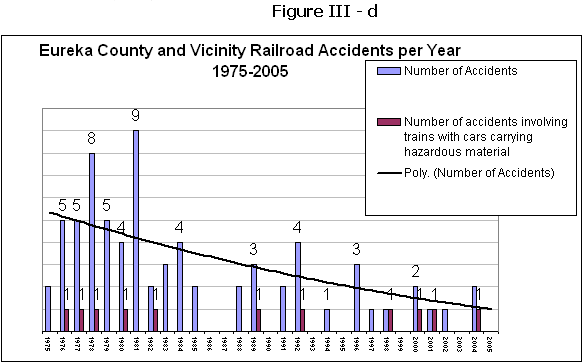
Perhaps the most striking aspect of Eureka County railroad accidents is the significant decline in accidents after the early 1980's. It is the opinion of some rail experts that the decline in accidents nationwide has to do with changed rail operations resulting from deregulation. The Staggers Rail Act of 1980 (named after Congressman Harley Staggers, D-WV, and passed under President Jimmy Carter) deregulated railroad operations. Before this Act, nine U.S. railroads were in bankruptcy, and others suffered poor returns. This led to deferred maintenance on both tracks and equipment. With the passage of the Staggers Act, railroads were able to abandon unprofitable lines and consolidate operations. Railroads were able to resume maintenance that had been deferred, and as maintenance increased accidents declined (Finkelstein, pers com).
The decreased accident rate also may be a result of the FRA's Safety Assurance and Compliance Program (SACP) which was initiated to address the problem of increased safety issues. In this program, the FRA works with major railroads to find root causes of safety problems, develops solutions cooperatively with the railroads, and enters into agreements with railroads to address specific issues to improve safety. (Moore, pers com.) Union Pacific initiated a Safety Assurance Compliance Program in 1997. In this program, Union Pacific management, 12 rail unions and the FRA address safety issues related to crew management, train dispatching, fatigue, training, culture, and inspections and testing.
In an October 2004 Las Vegas Sun article, "Moving Deadly Cargo," it is reported, however, that after 20 years of steady declines in railroad accidents, with accidents nationwide hitting a low of 2,397 in 1997, the accident trend is again upward, with 2,958 reported accidents in 2003. Figure III-d shows, however, the overall accident trend in the Eureka study area is still down.
Deregulation eventually may also have some less positive safety impacts, reports the Las Vegas Sun article. Nevada nuclear waste transportation consultant Robert Halstead was quoted in the article: "deregulation caused major railroads to reduce the amount of track they use nationally from 165,000 miles to 100,000, resulting in heavier traffic along the tracks still in use...this increases the chances for train accidents."
Halstead was quoted as saying, "The desire of the railroads to maximize profits has led them to do things that have major safety implications, like having 110 cars per train instead of 100, and increasing the payload per train."

The FRA reporting system breaks down accidents by cause: equipment, track, human, miscellaneous, and signal. In the study area, 44% of accidents were equipment-caused; 25% were track-caused; 24% were human-caused; 7% had miscellaneous causes; and none were caused by signals.
*
The percentage of human-caused accidents shown may be low. Other reports examining rail operations in Nevada conclude that human factors, such as rule violations by train crews and improper train handling, may be the greatest cause of railroad accidents, nationally and in Nevada, and causes attributed to human factors may be under-reported by the railroads (Meeker, 1992; Impact Assessment Report, 2001).
Of the 2,958 accidents nationwide in 2003, 1,197 were caused by human error, the most since 1993. The Las Vegas Sun article quoted United Transportation Union spokesman Frank Wilner, who said, "We have a lot of crews working 12-hour shifts and then given only 10 hours off. A lot of people are getting only five or six hours of sleep a night. The problem is the railroads don't have enough crews. This has led to a significant reduction in morale and the increased potential for human error." Recent efforts by Union Pacific to recruit, hire and train additional personnel to meet high levels of demand may, however, alleviate this problem (Union Pacific Annual Report, 2004).
During the 30-year period in the study area, there were five major accidents (described above). While rail and equipment improvements carried out as a result of deregulation apparently were successful in cutting down the overall accident rate, in the study area all but one of the major accidents took place well after the 1980 deregulation. In accident reports the cause assigned to four of the major accidents was "track": bridge embankment and trackbed softening; broken rail; irregular track alignment compounded by human error in failing to cut out brake valves; and one unknown cause. The cause of the fifth major accident was assigned to "equipment:" a brake malfunction caused a wheel to flatten, breaking a switch and derailing the train.
Types of Accidents
Derailments were by far the most common type of accident in the study area, accounting for 81% of all accidents. An accident is classified as a derailment whenever on-track equipment leaves the rail for a reason other than a collision, explosion, or rail-highway crossing impact. There were two collisions during the time period, and eleven accidents described as "other." Three of the "other" accidents were highway-rail collisions in which freight trains struck vehicles at crossings.
Type of Track on Which Accident Occurred
Double tracks run throughout the study area, one used for eastbound traffic, one for westbound. Therefore, in comparison to areas with single track, there are few sidings used to allow trains to pass. In addition, there are fewer switching yards and industrial tracks in the study area than in more populated regions. Consistent with these conditions, 57% of accidents during the reporting period took place on the main track.
Type of Equipment Involved in Accident
Regarding the type of equipment involved in accidents within the study area, seventy-nine percent of accidents involved freight trains. Again, this is consistent with the nature of the railroad through Eureka County, where most of the rail traffic is long-distance freight moving through the area, rather than switching, passenger trains, or other equipment configurations.
Speed
The speed of equipment involved in accidents in the study area is generally low, with 59% traveling at 30 mph or less. The highest-speed accident that took place during the 30-year period was a collision of an Amtrak passenger train with a single rail car. The passenger train rounded a corner at 79 mph and struck the parked rail car, pushing it off the track. Total damage from this accident was $11,500, and there were no injuries or fatalities.
Accidents Involving Hazardous Materials
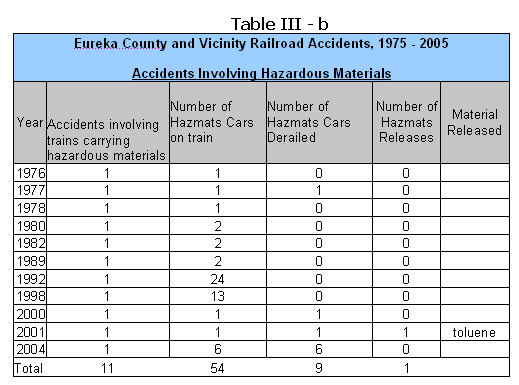
The reporting system requires that the presence of hazardous materials in accidents be reported. In the thirty-year period, 11 accidents involved trains carrying hazardous materials in 54 cars. Of these cars, nine were derailed or damaged in the accidents. There was only one hazardous materials release during that time period, in the June 25, 2001 Battle Mountain accident described above.
This table does not include the May 2003 incident in which a freight train hit an empty cyanide truck in a crossing at Beowawe, as that incident was not a part of the database used to build this table. While hazardous materials were not actually present in that incident (the truck was empty), it does point out the potential presence of hazardous materials on highway rail crossings in rural Nevada, where such materials are being hauled to and from gold mining operations.
It is important to note that this crossing is located adjacent to the Humboldt River, and the potential for a significant environmental disaster with a cyanide spill into the river would have been great if the cyanide truck had not been empty.
View Photo of this Accident
Injuries and Fatalities
In the 30-year period there was one fatality and four injuries. In a July 1983 accident in Palisade Canyon, a Carlin man was killed when the pickup truck in which he was a passenger, on the tracks but not at a crossing, was struck by a freight train. Three other occupants of the vehicle were injured. In a June 20, 1996 accident in Eureka County near Dunphy, a tractor-trailer truck was high-centered on a private crossing. The truck was struck by a freight train, and the driver, attempting to move the truck, was injured.
Historic (pre-1975) accidents
Accident reports for the period before 1975 are not available. In addition, according to the FRA (Finkelstein, pers. com.), such records would not be useful to predict potential future accident rates since railroad operations have changed significantly since that time. However, one of Nevada's best-known historic rail accidents took place in Eureka County. In August, 1939, a passenger train, "The City of San Francisco," derailed off a bridge in Palisade Canyon and five cars plunged into Humboldt River. One hundred and twenty-one people were injured and 24 killed. Sabotage was suspected but never proven.
Estimated Accident Rate
In 2003, approximately 27 trains per day passed over the UP tracks in the study area. This traffic level has stayed approximately the same since 2001. (Trains, July 2004). Assuming that the rate was also similar in 2000 and 2004, it is possible to roughly calculate the yearly accident rate in the study area for the current decade.
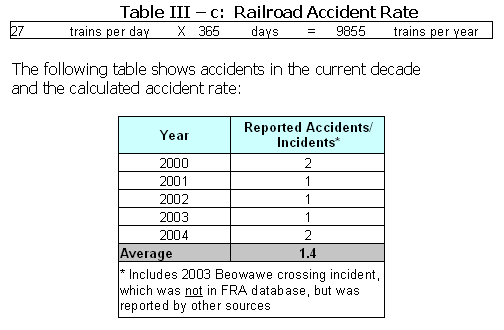 Recent accident/incident rates show that an average 1.4 accidents per year, or about 1.4 accidents per 9,855 trains, can be expected in the study area at current accident rates and traffic levels. As the detailed accident tables show, the accident is most likely to be small, causing around $35,000 damage, no casualties, and no hazardous releases.
It is important to note, however, that all but one of the five major accidents in the study area took place well after track and equipment improvements were carried out as a result of deregulation. The causes of all but one of these accidents were track failure of some kind. Consequently, while the average cost of an accident is only around $35,000, the potential for major accidents involving derailments, hazardous releases and injuries still remains, as the accident records demonstrate.
Wildland Fires
Eureka County firefighting personnel report that railroad operations in Eureka County and adjacent areas of Elko County may start almost 5 wildland fires per year; many of these may be ignited by sparks caused by friction between the equipment and the rail. (Tom Turk, pers com * ) The table in Appendix D shows details of the wildland fire incidents, including the location.
* While local fire professionals are of the opinion that these fires were started by trains, the railroad does not acknowledge this possibility; hence the use of the verb "may start", "may have been ignited" in this report.
|



